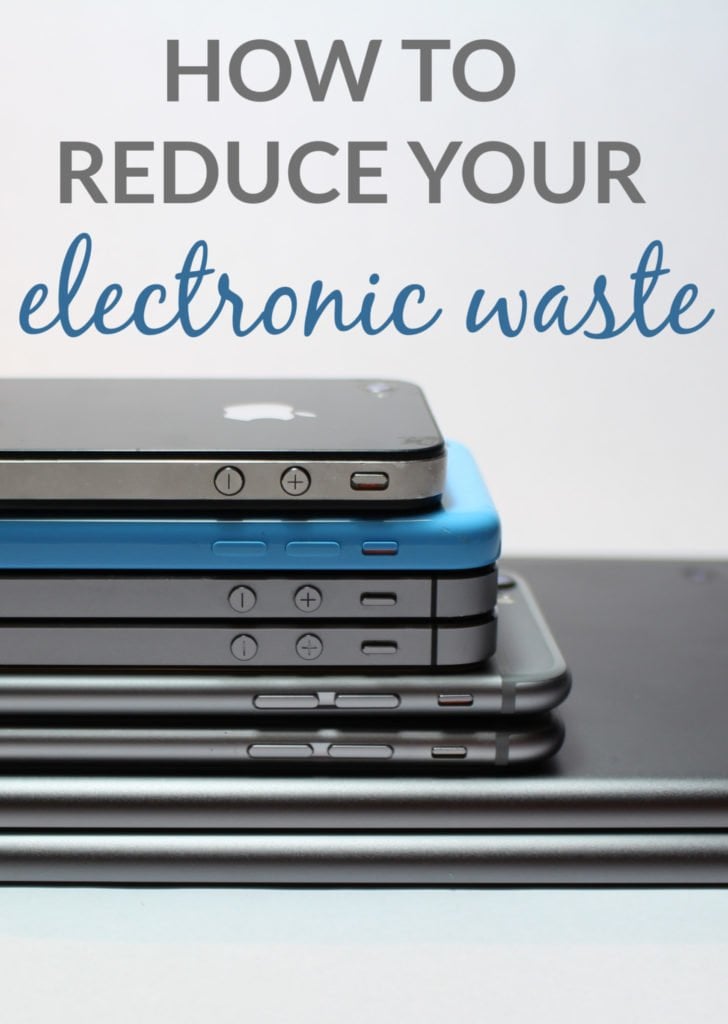10 Ways to Reduce E-Waste
Millions of tons of e-waste winds up in landfills each year. It’s one of the fastest-growing waste streams in the world. Here, we’re looking at 10 ways to reduce e-waste.
From repairing gadgets to responsibly recycling old devices, there are many ways to keep electronics out of landfills. These practical tips will help you minimize e-waste while protecting the planet and conserving resources.

What is E-Waste?
Electronic waste, or E-waste, is defined as “used electronics that are nearing the end of their useful life and are discarded, donated or given to a recycler.” It’s a problem because
- Many appliances and tech items are no longer designed to last. Planned obsolescence means cheap materials will cause an item to break faster or intentional design of a device that requires upgrading or replacing in a short time.
- These electronic devices contain toxic chemicals and heavy metals like lead, mercury, cadmium, and beryllium, PVC plastic, and brominated flame retardants. These toxins can seep out into the soil and water from a landfill or pile of “waiting to be recycled” waste. These toxins are harmful to wildlife and human health.
- Electronic devices are made of a complex mix of materials that include gold, silver, copper, platinum, palladium, lithium, cobalt and other valuable elements. The U.S. EPA reports that one metric ton of circuit boards can contain 40 to 800 times the amount of gold and 30 to 40 times the amount of copper mined from one metric ton of ore in the United States.
- In the United States alone, we generate about 6.9 million tons of e-waste each year. By the year 2030, the global estimate is 81 million tons annually.
- Only 17.4% of e-waste is being properly recycled worldwide.
There are mountains of e-waste in China. Some of it is there to be recycled, but most is waiting to be shipped off to e-waste landfills in Africa or other parts of Asia.
While reusing plastic, glass, and metals has become the norm, far less thought is given to recycling electronic items.
Think about how many people ditch their old mobile phones, tablets, or TVs for the newest model. Thanks to rapidly changing technology, the rise of disposable income, and availability of electronic products, it’s no surprise e-waste has become a major concern.
How to Reduce Your E-Waste
Minimizing electronic waste is one of the best ways to keep our environment safe. The good news is that there are some impactful and simple ways to reduce your e-waste. It just takes a little self control and mindfulness.
1. Consume Less
Of the 3 R’s (Reduce, Reuse, Recycle) Reduce is the most important. Some of us are accustomed to “needing” the newest model when a smart phone, computer, TV, or even coffee maker comes out.
Before buying one, ask yourself if you really need it. Does your existing version actually need replacing? If not, save your money and save yourself the time and trouble of setting up yet another device.
If you really need new products, can you buy a gently used or refurbished version? Being a sensible consumer will go a long way in productively managing your household’s e-waste.
2. Support the Right to Repair Movement
At least three states have enacted repair laws to counteract planned obsolescence, and there’s a federal Right to Repair movement that seems to be gaining ground.
Here’s where I get on my soapbox. My parents had a set of avocado green appliances from the late 70’s that lasted so long, my mom and I used to pray that the fridge would die so we could get another color. I think their toaster lasted 30 years.
My dad bought me a washer and dryer when I moved into my first apartment after college. The dryer lasted 21 years and through six moves. We left the washer in the last house we sold, but it was still going at age 24.
Conversely, I bought our son Amazon Basics space heater two years ago, and it stopped working last week. Of course, the warranty was for one year. I’m saving it for the next time we see my dad. He always repairs our old electronics or saves them for parts.
When in doubt about a warranty – just ask. Our Vitamix blender motor went out a few years ago, so I emailed their customer service. They sent a prepaid shipping label, and they fixed and returned it to me at no cost. They also offer refurbished models at discounted rates.
All that to say… things don’t last like they used to. And it’s crazy! We should have better technology now than when that avocado green refrigerator was built almost 50 years ago. Why aren’t we using it? The answer is clearly: greed.
So, please support state and federal legislation that requires companies to enhance consumers’ ability to repair their own devices and appliances. These laws require manufacturers to provide access to necessary parts, tools, and information for repairs. It is the absolute least they can do, and we should hold them accountable.
3. Donate or Sell Working Electronics
One simple way to efficiently manage e-waste is to simply sell your working electronics. Many buyers will use them, resell them, or use / sell the parts like my dad. Otherwise, there are recycling websites and comparison websites that will give you a price for your old gadgets and allow you to send them off, to be repurposed or recycled effectively.
Another great option is Cell Phones for Soldiers. Since 2004 Cell Phones For Soldiers has recycled more than 20 million cell phones, reducing the impact on landfills.
4. Recycle via a Retailer
Major retailers and brands have in-store, online, and drop-off site recycling options. They recycle computers, mobile phones, and TVs. A few years ago, some would allow you to trade your obsolete equipment for gift cards.
Before purchasing electronics, ask the store if they have a buyback program. Most large retailers offer that option to customers.
5. Use E-Cycling Centers in Your State
Another way to reduce your e-waste is to give all your electronics that can’t be donated or resold to free sites. Proper e-waste recycling involves disassembling the electronics, separating and categorizing the contents by material and cleaning them.
Items are then shredded mechanically for further sorting using advanced separation technologies. Companies must adhere to health and safety rules and use pollution-control technologies that reduce the health and environmental hazards of handling e-waste. (source)
6. Organize Your Electronics & Accessories
Given the number of electronics (and their chargers) we stash away in drawers and cupboards, it’s no wonder we forget what items we have. Instead of buying new chargers, cases, headphones, etc., organize your existing ones so they are easily found.
For example, you may need a memory stick but after organizing all your electronics, you find an unused one. Try to share gadgets, cords, and connectors with family members rather than buy the same device or charger multiple times.
7. Know Your State’s Laws About Battery Disposal
Rechargeable batteries contain hazardous waste which is why some states have made it illegal to throw them away in the trash, where they could contaminate a landfill. Home Depot offers this guide to battery recycling and disposal.
8. Repurpose Your Old Phone
Most people swap their old smartphones for a new one every year. Instead of letting it sit in a drawer, or worse, throwing it in the trash, consider using it for some other purpose. You can keep it in your car and use it as a GPS device or music player.
Boat owners often keep an old smart phone on board as a backup GPS. Old phones can be converted into universal remote controls or used to monitor security cameras. This tip is super useful and really pushes sustainability.
9. Buy ENERGY STAR Rated Appliances
The U.S. Environmental Protection Agency (EPA) continues to recognize products that meet stringent energy efficiency criteria through the ENERGY STAR program. Notably, the “ENERGY STAR Most Efficient 2025” designation highlights top-performing appliances across various categories, including refrigerators, dishwashers, and air conditioners.
10. Educate Yourself on the Materials Used in Electronics
Research about the raw materials being used to manufacture your mobile phone, dishwasher or laptop. Some materials are easy to recycle while others aren’t. Gadgets also contain a number of toxic materials.
The more you educate yourself, the more likely you’ll be able to purchase items that will not harm the environment in the long term.
Also, remember to wipe the memory on the device and factory reset your mobile device before selling, donating, or giving it away. Being more mindful of the electronics we consume and the role we can play in reducing e-waste can go a long way in helping the planet.
This article was published in 2017 and updated in January 2025.
More Ways to Go Green
If you learned something from these 10 ways to reduce e waste, you’ll also find these tips helpful.
The Problem With Single Use Plastic (and how to avoid it)
Regenerative Agriculture and the Future of Food
How to Shop Bulk & Zero Waste Stores
Plastic in Tea Bags (and the brands that don’t contain it)
The 15 Most Important Steps to Go Green


I would recommend to start using a compost bin, which for me is a much greener option for disposing off your garbage. In case you do not have enough space to house compost bin, you can also consider garbage disposal service provider like Junk Call who can come to you house and haul away your junk and then dispose it off in an eco-friendly manner.